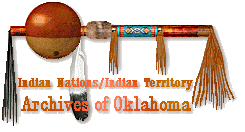Tulsa County
"Links
to web sites that are not part of the USGenWeb Project are provided for
your convenience
and do not imply any endorsement of the web sites or
their contents by The USGenWeb Project."
Sperry, Oklahoma
Brief history by Larry
Briggs
(February
2008)
The opening of the Bird Creek oil field and the completion of
the northern section of the Midland Valley Railroad (also known as the
Arkansas River Route) to Silverdale, Kansas, led to Sperry’s
birth. In 1905 the Midland Valley Railroad Company established a
flag station called Buehler at the present location of Sperry.
Charles Buehler worked for the Creek and Indiana Oil Company which was
developing several leases in the area. Mr. Buehler built a short
spur at the flag station to accommodate two or three tank cars. *1
Sperry’s original location on Hominy Creek about one and
one-half miles northeast of Buehler was plagued with constant
flooding. The post office was established there May 17,
1902, in a general store built on Cherokee land that was later allotted
to tribal member Fannie Ellis. William H. Carson had a
ranching operation that included this property, and it has been
confirmed that he was named first postmaster of Sperry at the Hominy
Creek location. According to one old-timer, the name Sperry was
suggested in honor of a Washington D. C. postal official. When
word reached area residents of the impending railroad construction in
1905, plans were made to move the post office to the Buehler
location. The exodus to Buehler began in 1906, and by 1907 the
resulting trackside settlement was renamed Sperry. Robert A.
Martin erected a frame building west of the railroad tracks to house
the post office and a general store, and he became the first postmaster
at the new location. The town well was also located on his
property. The new town site began to build out from the
intersection of four Cherokee land allotments; Henry Spybuck on the
southeast, Henry Evans, a minor, on the northwest, Minnie Spybuck
(later Tinker) on the southwest and Lucy Chisholm on the northeast.
Railroad literature initially listed the town as Beulah (a misspelling
of Buehler), and not until 1909 was the correct designation Sperry
printed on railroad timetables.
Sperry’s rich military history dates to December 1861, when
Union loyalists led by Creek chief Opothleyahola were scuttled into
Kansas by a Confederate unit led by Col. D. H. Cooper, and comprised of
Choctaw, Chickasaw, Cherokee, and Creek troops, as well as five hundred
or so Texas Cavalrymen. The skirmishes took place about two and
one-half miles southeast of present-day Sperry in the Horseshoe Bend
area of Bird Creek (86th St. North and Lewis Avenue).
The battle was known by several names, including Caving Banks,
Chustotalasah, High Shoals, Horseshoe Bend and Bird Creek.
In 1923, Col. Charles Taylor organized the first-ever high
school ROTC unit in the state at Sperry High School. In 1924, he
was instrumental in forming the Sperry unit of the Oklahoma National
Guard (120th Ammunition Training Unit) in a brick building
on East Main Street (the building was restored in 2000 by Larry
Briggs). Guard unit members mustered out to WWII from this store
front location in September 1940, but returned to a sprawling new
WPA-built armory that had been dedicated in 1941 on the site of the old
town baseball field. The armory building housed various military
units until 1990, and in 1991 the complex was deeded to the Town of
Sperry by Tulsa County commissioners. Town offices were
immediately moved into the facility, where they have remained. In
2007, taxpayers funded a $500,000 remodel of the armory complex.
Cattle ranching and oil production dominated the rural areas
surrounding early-day Sperry. The community was a typical oil
boom town, teeming with rowdy cowboys, roughnecks and
entrepreneurs. Tulsa Rig and Reel had a location in town,
furnishing lumber, materials and construction services for wooden oil
well derricks. The first brick buildings in town were constructed
about 1912, next to steep-gabled false-fronted frame buildings along
the Midland Valley Railroad right-of-way. In later years, brick
storefronts were angled to parallel the southeast to northwest
alignment of the railroad tracks, and wooden sidewalks disappeared in
the late teens. Eight trains passed through Sperry daily in the
teens and twenties, carrying oil, chemicals, cattle, freight and
passengers.
In 1911 Washington Elementary School opened in a two-story
brick facility on Main Street, one block west of the tracks. Area
students previously had chosen from among Greenwood Chapel, Flat Rock,
Blackburn, and Delaware schools. A new brick high school building
was completed in 1922, on the site of the present campus, and in 1956,
a modern elementary school was added nearby. Sperry’s present
middle school was constructed on the site formerly occupied by the old
high school after it was destroyed by fire in 1984. As of 2008,
over 1300 students attend Sperry Schools, attesting to rapid growth in
the lake region west of town.
On April 18, 1917, some ten years after arriving at the
Midland Valley Railroad location, Sperry residents filed into the
William McNeil Air Dome (movie theater) and finally voted to
incorporate the town, the papers being filed on May 7 of that
year. The muddy and narrow “Tulsa Road” was paved in 1920,
featuring two right-angle turns, one in downtown Sperry, and the other
a mile east of town at “Dead Man’s Corner”. The new two-lane
concrete highway (now North Peoria Avenue and North Cincinnati Avenue)
put an end to automobiles sinking to their axles in knee-deep mud.
Once dependent on wells for drinking water, Sperry residents
got a taste of cool, clear Spavinaw water in 1926. City officials
from Tulsa turned the first tap at a Sperry fire hydrant during a
formal ceremony. One year later a natural gas pipeline was built
into the bustling town, making use of the area’s vast gas reservoirs.
Although outhouses stood well into the nineteen-sixties,
Sperry’s controversial new sewer system was constructed in 1956.
That same year, a brand new Ford fire truck appeared in the homecoming
parade, proudly driven by members of the volunteer fire department.
In the late nineteen-nineties, the railroad right of way was
“abandoned” despite the efforts of many residents who were fighting to
preserve the railroad. In 2006 the rails and crossties were
removed, and the 100 foot wide right-of-way was transformed into the
Osage Trail, a scenic jogging, cycling, and equestrian path stretching
from Tulsa to Skiatook. The trail is under control of the Tulsa
County Parks Department.
Larry Briggs (February 2008)
*1 History of Tulsa, by C. B. Douglas 1921
This page was last updated on
03/16/13

God Bless America
Hosted & © 2025
by

OKGenWeb State
Coordinator
Linda
Simpson
Asst:
Mel Owings
|
©
1996-Present
~ OKGenWeb Coordinator ~ All Rights Reserved
NOTICE: In keeping with our policy of providing
free Information on the Internet, data may be used by
non-commercial entities, as long as this message remains on all
copied material. These electronic pages may NOT be reproduced in
any format for profit or for presentation by other persons or
organizations. Files may be printed or copied for Personal use
only. Persons or organizations desiring to use this material for
purposes other than stated above must obtain the written consent
of the file contributor. |







